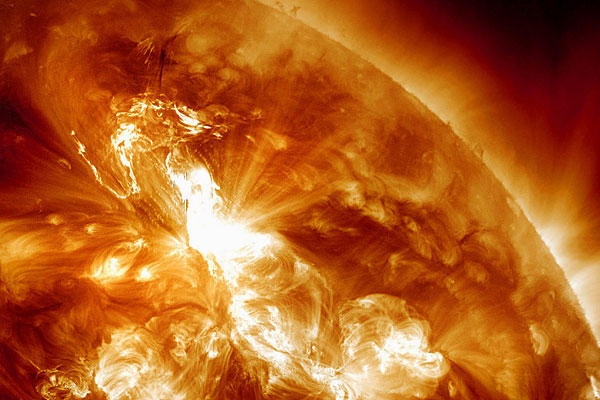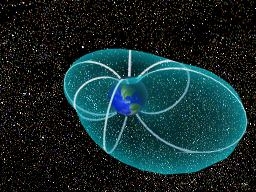
28 January 2012:
Last weekend’s solar flare made the news with beautiful images from NASA’s Solar Dynamics Observatory.
On January 23 at 4am UTC (January 22 11pm in Pittsburgh) a huge “burp” of charged particles and magnetic fields burst off the sun from Active Region 1402. The wave traveled at 2,200 km/second — 150 times slower than the speed of light — so we saw it before we “felt” it on January 24 around 1400 GMT (January 24, 9am EST, plus or minus 7 hours).
Major pulses from the sun can cause outages in the electric grid and interference with radio and TV broadcasts and communication devices. The episode I best remember was when a pulse killed Telstar 401 and stopped PBS broadcasting until they could find a new satellite and we re-pointed our station dish.
Earth’s magnetic field protects us from these “burps” but it gets distorted while doing so. In normal times the solar wind squashes our magnetic field on the earth’s sunward (day) side and elongates on the night side. Here’s a diagram from NASA showing how that works with the sun positioned at top left.

In a solar flare event the magnetic bulge on the night side gets longer, the loops break and they “flap in the breeze.” When the field snaps back it releases energy that whacks the earth’s upper atmosphere, causing the beautiful northern lights and sometimes electro-magnetic interference.
Meanwhile nothing much happened here on Earth except …
On Tuesday morning January 24 around 7am, an electrical transformer at WQED blew up and burned. It was quickly extinguished and the damage was minor, but it left us without electricity. Thanks to our generator we remained on the air and on the web. All day Tuesday and into the night, the electricians worked hard to hook up a temporary power feed. Unfortunately, when they switched us back to house power on Wednesday morning at 2am an internal surge tripped a breaker on our emergency grid and we went off the air and off the web.
So it’s been an exciting week for us in technology at WQED. The flare probably didn’t cause our electrical problem but the timing was quite a coincidence.
Watch what happened on the sun in this cool video from NASA SDO:
(All photos from NASA. Click on the images to see the originals.)
I agree, the solar flare wouldn’t cause a can to blow!
Rob
The same Active Region threw another, stronger flare on Jan 27.
Is it, that geomagnetic storms on Earth follow in ~ 2-3 days after flare?
I do sometimes look on http://spaceweather.com/ site and http://dx.qsl.net/propagation/
Yes, the wave doesn’t travel as fast as light. I don’t know if some waves travel faster than others, though.
This week, wed & thu I had pretty bad cramps in my one legs muscle below the knee, could it possibly did happen because of geomagnetic storms? I’ve heard, that human health is affected by the geomagnetic storms, it’s pretty dangerous for those with heart conditions.